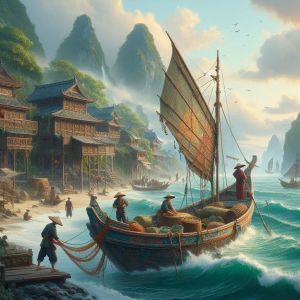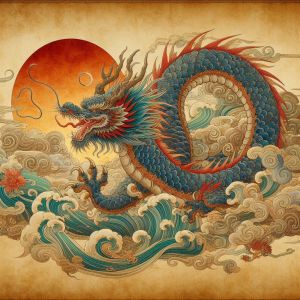Igochians

The Igochians, or as they call themselves, the Ryusei-no Hami, meaning "people of the sun" in the common tongue, are a noble and honorable subrace of humans. They originate from the eastern continent of Igochi. Though it is not unusual to see Igochians in other, far-away lands, the majority of their people are still deeply rooted in their continent of origin.
Igochians hail from a land of rolling steppes, majestic mountains, and serene coastal villages, each region contributing uniquely to the Igochian identity and diversity. The Igochians are a people of contrasts—warriors and poets, farmers and scholars, united by a common heritage, their desire to attain perfection in every aspect of their lives, and an unyielding spirit.
Description
Igochians, on average, are similar in size to other humans, though they tend to be slightly shorter. Women in particular often exhibit a leaner physique. Their skin tones span from light brown to pale white, reflecting the diverse environments of their homeland.
The Igochians predominantly have hair that is either black or dark brown, colors as deep and rich as the ink used in their traditional calligraphy. A rare few are born with white hair, a trait that is seen as a divine blessing, marking them as individuals touched by the heavens. This distinctive feature often brings reverence and respect from their peers.
Their eyes are usually dark brown, like the fertile soil of their homeland, but it is not uncommon to find Igochians with lighter brown, grey, or even the rare and mystical purple eyes. These unique eye colors are often celebrated, thought to signify inner strength and wisdom.
Society

Igochian societies are shaped profoundly by three factors: the surrounding environment, social status, and an inherent inclination towards perfectionism imbued in every individual.
The varied terrains and environments of Igochi have created a rich and diverse society. The type of land where a particular community exists greatly influences the activities its people pursue and their way of life. It is common for Igochians to form communities around specific activities, such as farming, fishing, or trade. The surrounding environment dictates not only their livelihoods but also their cultural practices and daily routines.
Social status plays a significant role in the daily life of an Igochian. Class barriers between nobles and commoners are distinctly marked, influencing where people live and how they interact. Commoners typically reside in small settlements or on the outskirts of major city centers. They lead simple lives, dedicating themselves to their trades and crafts, fostering a strong sense of community and mutual support.
Nobles, on the other hand, favor the centers of large cities, enjoying more luxurious lifestyles. These urban areas are hubs of culture and power, where noble families often reside in grand homes. Some nobles are esteemed warriors, while others devote themselves to artistic or scholarly pursuits, contributing to the cultural and intellectual wealth of Igochi.
An intrinsic inclination towards perfectionism permeates every aspect of Igochian life. Artisans work with meticulous precision, never rushing their crafts, and refusing to accept anything less than perfect results. Each act of creation is treated as a ceremony, a sacred process that honors their heritage and values. Whether weaving delicate silk, crafting intricate jade jewelry, or shaping elegant pottery, the Igochians infuse their work with a profound sense of purpose and reverence for their craft.
Architecturally, Igochian constructions are relatively simple but exhibit an extreme attention to detail. This meticulous craftsmanship is evident even in common buildings, reflecting the Igochian dedication to perfection. Larger structures, such as palaces and temples, are marvels of architecture and artistic expression, showcasing the society's aesthetic values and engineering prowess. These grand buildings stand as symbols of Igochian heritage, embodying their cultural pride and artistic achievements.
Economy

The Igochian economy is as diverse and vibrant as its landscapes, intricately woven from the varied resources and skills of its people. In the fertile regions of Igochi, lush fields of rice and tea stretch across the land, providing sustenance and trade goods. These farming communities form the backbone of the economy, their diligent efforts ensuring a steady supply of food and raw materials.
Along the serene coastlines, villages thrive on fishing and trade. The Igochians, skilled sailors, navigate their well-crafted vessels through bustling ports that serve as the lifeblood of commerce. Here, the exchange of goods with distant regions brings a wealth of exotic items and materials, enriching the local economy and fostering cultural exchange.
Known far and wide for their exceptional craftsmanship, Igochian artisans produce goods of unparalleled quality. Silks woven with intricate patterns and vibrant colors are highly prized, their delicate texture and stunning designs sought after by nobles and merchants alike. Jade jewelry, meticulously carved and polished, stands as a testament to their mastery of this precious stone, with pieces that range from elegant ornaments to elaborate ceremonial artifacts. Pottery, crafted with a keen eye for detail and aesthetic beauty, showcases the artistry of the Igochians, each piece a unique blend of functionality and art. These artisans are held in high regard, their work vital to the economic and cultural fabric of society.
In the heart of cities and towns, vibrant marketplaces buzz with activity. Merchants, their stalls brimming with a variety of goods, engage in lively trade. From fresh produce to rare imports, these markets are hubs of economic activity and social interaction, where deals are made and news is exchanged.
The patronage of nobles further stimulates economic and cultural growth. These affluent individuals sponsor artisans and scholars, commissioning works of art and funding research. This support not only enriches Igochian culture but also drives innovation and excellence in various fields.
Guilds play a crucial role in regulating trade and craft industries. Ensuring high standards and fair practices, these organizations provide support and training for their members. Guild halls are centers of community and professionalism, where knowledge is shared and traditions are upheld.
Overall, the Igochian economy thrives on a foundation of agriculture, trade, craftsmanship, and noble patronage, creating a dynamic and prosperous society.
Arts and Culture

Igochians' ceremonialism and perfectionism in their approach to creation result in some of the most exquisite and exceptional artistry in the world. Every craft honors their deep-rooted heritage and cultural values. Whether weaving delicate silk, crafting intricate jade jewelry, or shaping elegant pottery, Igochian artisans approach their work with a profound sense of purpose and reverence, ensuring that every detail is meticulously attended to.
Silk weaving is one of the most esteemed crafts in Igochian culture. Artisans spend countless hours creating delicate patterns, often inspired by nature and mythology. The resulting fabrics are not only used for clothing but also as wall hangings and ceremonial garments. Each piece of silk is a testament to the weaver's skill and dedication, with no detail overlooked.
Igochian pottery is celebrated for its elegance and precision. Each piece is carefully shaped and painted, often depicting scenes of daily life, folklore, and the natural world. Pottery items range from everyday utensils to elaborate decorative pieces. The creation process is meticulous, with artisans striving for perfection in every curve and line, ensuring that each work is both functional and beautiful.
Jade is a highly prized material in Igochi, and the skill of jade carving is passed down through generations. Igochian jade jewelry and ornaments are renowned for their intricate details and symbolic meanings. Carving jade is considered a highly spiritual act, with carvers often entering a meditative state to ensure their work honors the stone's natural beauty and significance.
Music, dance, and theater are integral parts of Igochian culture. Traditional instruments create the melodic backdrop for performances. Dances often tell stories of historical events, legendary heroes, and the beauty of nature. Theater, both traditional and contemporary, explores themes of honor, love, and conflict. Performers dedicate years to perfecting their craft, ensuring every movement and note is executed with precision and emotion.
Painting is another revered art form in Igochian culture. Igochian paintings often depict serene landscapes, historical scenes, and mythological tales, capturing the essence of their world with grace and precision. Artists use fine brushes and natural pigments to create intricate details and vibrant colors, often spending months or even years perfecting a single piece. Each painting is a reflection of the artist's inner vision and technical mastery, embodying the Igochian ideals of beauty, balance, and harmony. The process of painting is considered a meditative practice, where artists seek to achieve a perfect harmony between mind, brush, and canvas.
Calligraphy is not just a form of writing but an art form in its own right. The Igochians have a rich literary tradition, with poetry, philosophical texts, and epic tales being highly valued. Calligraphers are respected for their ability to convey deep meaning through the beauty of their script. The act of writing is a meditative practice, with each stroke of the brush performed with careful deliberation and skill.
Igochians take great pride in their gardens, which are designed to reflect harmony and balance. These spaces often include carefully arranged plants, water features, and stone structures, creating a serene environment for contemplation and relaxation. Gardening is considered an art form, with gardeners striving to achieve a perfect balance between natural beauty and human artistry.
Overall, Igochian arts and culture are defined by a relentless pursuit of perfection, where every craft is a ceremony, and every creation is a tribute to their cultural heritage and values.